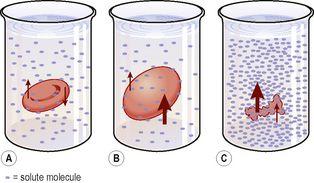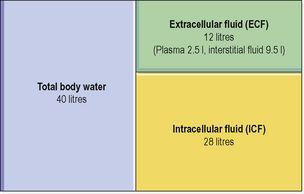Ross & Wilson Anatomy and Physiology in Health and Illness (15 page)
Read Ross & Wilson Anatomy and Physiology in Health and Illness Online
Authors: Anne Waugh,Allison Grant
Tags: #Medical, #Nursing, #General, #Anatomy

Plasma osmolarity is maintained within a very narrow range because if the plasma water concentration rises, i.e. the plasma becomes more dilute than the intracellular fluid within the red blood cells, then water will move down its concentration gradient across their membranes and into the red blood cells. This may cause the red blood cells to swell and burst. In this situation, the plasma is said to be
hypotonic
. Conversely, if the plasma water concentration falls so that the plasma becomes more concentrated than the intracellular fluid within the red blood cells (the plasma becomes
hypertonic
), water passively moves by osmosis from the blood cells into the plasma and the blood cells shrink (
Fig. 2.13
).
Figure 2.13
The process of osmosis.
Net water movement when a red blood cell is suspended in solutions of varying concentrations (tonicity):
A.
Isotonic solution.
B.
Hypotonic solution.
C.
Hypertonic solution.
Body fluids
Learning outcomes
After studying this section, you should be able to:
define the terms intra- and extracellular fluid
using examples, explain why homeostatic control of the composition of these fluids is vital to body function.
The total body water in adults of average build is about 60% of body weight. This proportion is higher in babies and young people and in adults below average weight. It is lower in the elderly and in obesity in all age groups. About 22% of body weight is extracellular water and about 38% is intracellular water (
Fig. 2.14
).
Figure 2.14
Distribution of body water in a 70 kg person.
Extracellular fluid
The extracellular fluid (ECF) consists mainly of blood, plasma, lymph, cerebrospinal fluid and fluid in the interstitial spaces of the body. Other extracellular fluids are present in very small amounts; their role is mainly in lubrication, and they include joint (synovial) fluid, pericardial fluid (around the heart) and pleural fluid (around the lungs).
Interstitial or intercellular fluid (tissue fluid) bathes all the cells of the body except the outer layers of skin. It is the medium through which substances pass from blood to the body cells, and from the cells to blood. Every body cell in contact with the ECF is directly dependent upon the composition of that fluid for its well-being. Even slight changes can cause permanent damage, and ECF composition is, therefore, closely regulated. For example, a fall in plasma potassium levels may cause muscle weakness and cardiac arrhythmia, because of increased excitability of muscle and nervous tissue. Rising blood potassium also interferes with cardiac function, and can even cause the heart to stop beating. Potassium levels in the blood are only one of the many parameters under constant, careful adjustment by the homeostatic mechanisms of the body.
Intracellular fluid
The composition of intracellular fluid (ICF) is largely controlled by the cell itself, because there are selective uptake and discharge mechanisms present in the cell membrane. In some respects, the composition of ICF is very different from ECF. Thus, sodium levels are nearly ten times higher in the ECF than in the ICF. This concentration difference occurs because, although sodium diffuses into the cell down its concentration gradient, there is a pump in the membrane that selectively pumps it back out again. This concentration gradient is essential for the function of excitable cells (mainly nerve and muscle). Conversely, many substances are found inside the cell in significantly higher amounts than outside, e.g. ATP, protein and potassium.
For a range of self-assessment exercises on the topcs in this chapter, visit
www.rossandwilson.com
.
CHAPTER 3
The cells, tissues and organisation of the body
The cell: structure and functions
28
Plasma membrane
28
Organelles
28
The cell cycle
31
Transport of substances across cell membranes
31
Tissues
33
Epithelial tissue
34
Connective tissue
35
Muscle tissue
38
Nervous tissue
40
Tissue regeneration
40
Membranes
40
Glands
41
Organisation of the body
41
Anatomical terms
41
The skeleton
41



